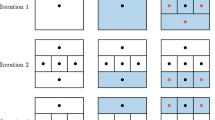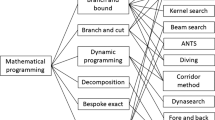Abstract
Semidefinite optimization is a strong tool in the study of NP-hard combinatorial optimization problems. On the one hand, semidefinite optimization problems are in principle solvable in polynomial time (with fixed precision), on the other hand, their modeling power allows to naturally handle quadratic constraints. Contrary to linear optimization with the efficiency of the Simplex method, the algorithmic treatment of semidefinite problems is much more subtle and also practically quite expensive. This survey-type article is meant as an introduction for a non-expert to this exciting area. The basic concepts are explained on a mostly intuitive level, and pointers to advanced topics are given. We provide a variety of semidefinite optimization models on a selection of graph optimization problems and give a flavour of their practical impact.
Similar content being viewed by others
References
Anjos MF (2005) Semidefinite optimization approaches to satisfiability and maximum-satisfiability problems. J Satisf Boolean Model Comput 1:1–47
Anjos MF, Lasserre JB (eds) (2012) Handbook on semidefinite, conic and polynomial optimization. International series in Operations Research and Management Science. Springer, Berlin
Anjos MF, Kennings A, Vanelli A (2005) A semidefinite optimization approach for the single-row layout problem with unequal dimensions. Discret Optim 2:113–122
Applegate DL, Bixby RE, Chvátal V, Cook WJ (2006) The traveling salesman problem. A computational study. Princeton University Press, Princeton
Barahona F, Grötschel M, Mahjoub A (1985) Facets of the bipartite subgraph polytope. Math Oper Res 10: 340–358
Barahona F, Jünger M, Reinelt G (1989) Experiments in quadratic 0–1 programming. Math Program 44: 127–137
Barahona F, Mahjoub A (1986) On the cut polytope. Math Program 36:157–173
Blekherman G, Parillo PA, Thomas R (2012) Semidefinite optimization and convex algebraic geometry. (forthcoming)
Buchheim C, Wiegele A, Zheng L (2009) Exact algorithms for the quadratic linear ordering problem. INFORMS JComput 22:168–177
Burkard RE, Dell’Amico M, Martello S (2009) Assignment problems. SIAM, Philadelphia, PA
Chimani M, Hungerländer P, Jünger M, Mutzel P (2011) An SDP approach to multi-level crossing minimization. In: Proceedings of algorithm engineering & experiments [ALENEX’2011]
de Klerk E (2002) Aspects of semidefinite programming: interior point algorithms and selected applications. Kluwer Academic Publishers, Dordrecht
de Klerk E, Pasechnik DV, Warners JP (2004) On approximate graph colouring and Max-\(k\)-Cut algorithms based on the \(\vartheta \)-function. J Comb Optim 8(3):267–294
De Simone C (1990) The cut polytope and the Boolean quadric polytope. Discrete Math 79(1):71–75
Delorme C, Poljak S (1993) Laplacian eigenvalues and the maximum cut problem. Math Program 62: 557–574
Deza M, Grishukhin VP, Laurent M (1993) The hypermetric cone is polyhedral. Combinatorica 13:397–411
Duffin RJ (1956) Infinite programs. Ann Math Stud 38:157–170
Fischer I, Gruber G, Rendl F, Sotirov R (2006) Computational experience with a bundle method for semidefinite cutting plane relaxations of max-cut and equipartition. Math Program 105:451–469
Frieze A, Jerrum M (1997) Improved approximation algorithms for Max \(k\)-Cut and Max Bisection. Algorithmica 18(1):67–81
Ghaddar B, Anjos MF, Liers F (2011) A branch-and-cut algorithm based on semidefinite programming for the minimum \(k\)-partition problem. Ann Oper Res 188:155–174
Goemans MX, Williamson DP (1995) Improved approximation algorithms for maximum cut and satisfiability problems using semidefinite programming. J ACM 42:1115–1145
Goemans MX, Williamson DP (2004) Approximation algorithms for max-3-cut and other problems via complex semidefinite programming. J Comput Syst Sci 68(2):442–470
Halperin E, Zwick U (2002) A unified framework for obtaining improved approximation algorithms for maximum graph bisection problems. Random Struct Algorithms 20:382–402
Hastad J (1997) Some optimal inapproximability results. In: Proceedings 29th symposium on the theory of computing, pp 1–10
Helmberg C (2000) Fixing variables in semidefinite relaxations. SIAM J Matrix Anal Appl 21(3): 952–969
Helmberg C (2002) Semidefinite programming. Eur J Oper Res 137:461–482
Helmberg C, Rendl F (1998) Solving quadratic (0,1)-problems by semidefinite programming and cutting planes. Math Program 82:291–315
Helton JW, Nie J (2010) Semidefinite representation of convex sets. Math Program (A) 122:21–64
Hungerländer P (2012) Semidefinite approaches to ordering problems. PhD thesis, Alpen-Adria University Klagenfurt, Austria
Hungerländer P, Rendl F (2012) Semidefinite relaxations of ordering problems. Math Program (B), (forthcoming)
Jäger G, Srivastav A (2005) Improved approximation algorithms for maximum graph partition problems. J Comb Optim 10:133–167
Jünger M, Lee EK, Mutzel P, Odenthal T (1997) A polyhedral approach to the multi-layer crossing minimization problem. In: GD ’97: Proceedings of the 5th international symposium on graph drawing, pp 13–24. Springer, Berlin
Jünger M, Mutzel P (1997) 2-layer straightline crossing minimization: performance of exact and heuristic algorithms. J Graph Algorithms Appl 1:1–25
Karisch SE, Rendl F (1998) Semidefinite programming and graph equipartition. Fields Inst Commun 18: 77–95
Karp RM (1972) Reducibility among combinatorial problems. In: Miller RE, Thather JW (eds) Complexity of computer computation. Plenum Press, New York, pp 85–103
Keil JM, Brecht TB (1991) The complexity of clustering in planar graphs. J Comb Math Comb Comput 9:155–159
Kernighan BW, Lin S (1970) An efficient heuristic procedure for partitioning graphs. Bell Syst Tech J 49:291–307
Khot S (2010) On the unique games conjecture. In: Proceedings of the 25th IEEE conference on computational complexity, pp 99–121
Lasserre JB (2010) Moments, positive polynomials and their applications. Imperial College Press, London
Laurent M, Rendl F (2005) Semidefinite programming and integer programming. In: Aardal K, Nemhauser GL, Weismantel R (eds) Discrete optimization. Elsevier, Amsterdam, pp 393–514
Lee J, Leyffer S (eds) (2012) Mixed integer nonlinear programming. IMA volumes in applied mathematics and its applications. Springer, Berlin
Lovász L (1979) On the Shannon capacity of a graph. IEEE Trans Inf Theory 25:1–7
Lovász L (2003) Semidefinite programs and combinatorial optimization. In: Reed BA, Sales CL (eds) Recent advances in algorithms and combinatorics. CMS books in mathematics. Springer, Berlin, pp 137–194
Lovász L, Schrijver A (1991) Cones of matrices and set-functions and 0–1 optimization. SIAM J Optim 1:166–190
Malick J, Roupin F (2011) Solving k-cluster problems to optimality with semidefinite programming. Technical report, CNRS, Grenoble, France
Marti R, Reinelt G (2011) The linear ordering problem: exact and heuristic methods in combinatorial optimization. Applied Mathematical Sciences. Springer, Berlin
Nesterov Y (1997) Quality of semidefinite relaxation for nonconvex quadratic optimization. Technical report, CORE
Nesterov Y, Nemirovski AS (1994) Interior point polynomial algorithms in convex programming. SIAM Publications, SIAM, Philadelphia
Padberg M (1989) The quadric Boolean polytope: some characteristics, facets and relatives. Math Program 45:139–172
Pardalos PM, Rodgers GP (1990) Computational aspects of a branch and bound algorithm for quadratic zero-one programming. Computing 45:131–144
Rendl F (2009) Semidefinite relaxations for integer programming. In: Jünger M, Liebling ThM, Naddef D, Nemhauser GL, Pulleyblank WR, Reinelt G, Rinaldi G, Wolsey LA (eds) 50 years of integer programming 1958–2008. Springer, Berlin, pp 687–726
Rendl F, Rinaldi G, Wiegele A (2010) Solving max-cut to optimality by intersecting semidefinite and polyhedral relaxations. Math Program 212:307–335
Rendl F, Sotirov R (2007) Bounds for the quadratic assignment problem using the bundle method. Math Program (B) 109:505–524
Roupin F (2004) From linear to semidefinite programming: an algorithm to obtain semidefinite relaxations for bivalent quadratic problems. J Comb Optim 8:469–493
Schrijver A (2003) Combinatorial optimization. Polyhedra and efficiency A, volume 24 of algorithms and combinatorics. Springer, Berlin
Sherali HD, Adams WP (1990) A hierarchy of relaxations between the continuous and convex hull representations for zero-one programming problems. SIAM J Discrete Math 3(3):411–430
Sherali HD, Adams WP (1994) A hierarchy of relaxations and convex hull characterizations for mixed-integer zero-one programming problems. Discrete Appl Math 52(1):83–106
Shor NZ (1987) An approach to obtaining global extremums in polynomial mathematical programming problems. Kibernetika 5:102–106
Tunçel L (2010) Polyhedral and semidefinite programming methods in combinatorial optimization. Fields Institute Monographs. American Mathematical Society, Providence, RI
Vallentin F (2008) Lecture notes: semidefinite programs and harmonic analysis. Technical report. Tilburg University, The Netherlands
Vandenberghe L, Boyd S (1996) Semidefinite programming. SIAM Rev 38:49–95
Wolkowicz H, Saigal R, Vandenberghe L (eds) (2000) Handbook of semidefinite programming. Kluwer, Dordrecht
Zhao Q, Karisch SE, Rendl F, Wolkowicz H (1998) Semidefinite programming relaxations for the quadratic assignment problem. J Comb Optim 2:71–109
Zhao X, Sun D, Toh K (2010) A Newton CG augmented Lagrangian method for semidefinite programming. SIAM J Optim 20:1737–1765
Acknowledgments
I thank Miguel Anjos and an anonymous referee for giving numerous suggestions to improve the presentation.
Author information
Authors and Affiliations
Corresponding author
Rights and permissions
About this article
Cite this article
Rendl, F. Semidefinite relaxations for partitioning, assignment and ordering problems. 4OR-Q J Oper Res 10, 321–346 (2012). https://doi.org/10.1007/s10288-012-0210-3
Received:
Revised:
Published:
Issue Date:
DOI: https://doi.org/10.1007/s10288-012-0210-3




